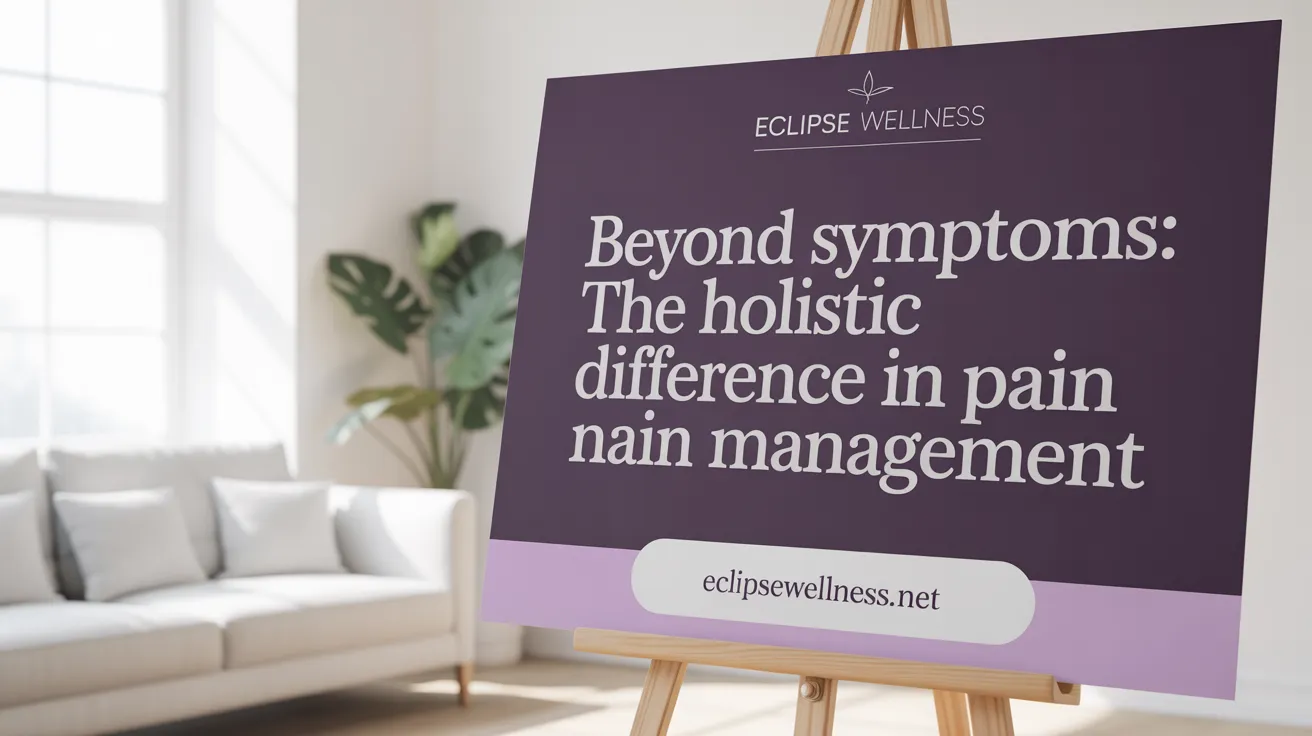Understanding Integrative Pain Management
Chronic pain remains a persistent challenge for millions globally, often resisting conventional medical treatments. As a result, integrative pain management has emerged as a comprehensive and patient-centered approach that combines traditional and complementary therapies to address the multifaceted nature of chronic pain. This article explores how this holistic methodology transforms pain care, highlighting its therapies, effectiveness, and future potential.
Defining Integrative Pain Management
What is integrative pain management and how is it defined?
Integrative pain management is an approach that combines multiple evidence-based treatments to address chronic pain in a comprehensive, personalized way. It goes beyond just symptom management by focusing on the whole person, considering biological, psychological, and social factors, often referred to as the biopsychosocial model.
This method emphasizes crafting individualized treatment plans that incorporate a variety of therapies, such as acupuncture, massage, physical therapy, mind-body techniques like meditation, and nutritional guidance. These treatments are coordinated in a way that may be simultaneous or sequential, depending on what is most effective and acceptable for the patient.
A core feature of integrative pain care is active patient engagement and empowerment. Patients are encouraged to participate actively in developing and adhering to their treatment strategies. This collaborative approach aims to improve pain relief, enhance overall functionality, and reduce dependency on medications like opioids.
The overarching goal is to treat pain through mechanisms that target its root causes and contributing factors, resulting in better quality of life. By integrating diverse modalities supported by scientific evidence, this strategy fosters a holistic, mechanism-guided, and patient-centered approach that adapts to individual needs and preferences.
Implementing this model involves understanding the interconnectedness of physical health, mental health, social well-being, and lifestyle, promoting a more balanced and sustainable form of pain management.
Alternative and Complementary Therapies in Chronic Pain Care
What are some alternative and complementary therapies used in chronic pain management?
Managing chronic pain goes beyond conventional medicine, as many patients seek additional options to improve their quality of life. Several therapies have gained recognition for their potential benefits.
Acupuncture, which involves inserting thin needles into specific points on the body, has shown positive effects in relieving neck, lower back, and osteoarthritis pain with excellent safety profiles. Massage therapy, through pressing and rubbing muscles and soft tissues, can reduce pain and improve mobility, especially in conditions like neck pain and post-surgery recovery.
Yoga and other mind-body practices incorporate physical movements, breathing exercises, and meditation to help manage pain. Studies have shown yoga significantly relieves chronic neck pain and is comparable to physical therapy for lower back pain, with effects lasting up to a year.
Chiropractic care and spinal manipulation involve hands-on techniques that focus on musculoskeletal alignment. Evidence supports their use for acute lower back pain, often resulting in high patient satisfaction, though results for chronic back conditions are less conclusive.
Herbal medicine and dietary supplements, such as avocado and soybean unsaponifiables, devil's claw, capsaicin topical applications, omega-3 fatty acids, glucosamine, and SAMe, have been shown to reduce osteoarthritis pain and may lessen reliance on NSAIDs.
While energy-based therapies like Reiki and electromagnetic field treatments are popular among some patients, current research offers mixed results, indicating a need for more rigorous studies.
Integrating these therapies with standard treatments—under careful medical supervision—can create a comprehensive approach. This combined strategy aims to address not only physical symptoms but also psychological and social factors influencing chronic pain.
What is the evidence for selected therapies?
The evidence supporting these therapies varies. For example, the 1996 NIH technology assessment conference highlighted substantial support for mind-body therapies like hypnosis, meditation, and biofeedback as adjunct pain treatments.
The 1997 NIH consensus on acupuncture place promising results for pain related to dental issues, temporomandibular dysfunction, and arthritis, linked to neurotransmitter release.
Massage therapy, chiropractic care, and spinal manipulation are well supported for acute back pain, with patient satisfaction often exceeding that of standard medical care. However, data for long-term benefits in chronic conditions remains inconsistent.
Herbal and nutritional supplements have demonstrated benefits in osteoarthritis management, potentially reducing the use of NSAIDs and related risks.
Overall, combining traditional and alternative therapies can help tailor pain management plans that address individual needs and preferences, fostering better outcomes.
Benefits and Research Supporting Integrative Pain Approaches

What evidence exists regarding the benefits and effectiveness of integrative approaches in pain management?
Recent studies and reviews have shown that integrative therapies such as acupuncture, mindfulness-based practices like meditation and Qi Gong, massage therapy, and cognitive behavioral techniques are effective additions to conventional pain management. These approaches not only help in reducing pain severity but also enable patients to decrease their reliance on opioid medications, which are often associated with adverse effects and addiction risks.
The National Center for Complementary and Integrative Health (NCCIH) actively funds and studies these nondrug interventions. Their research aims to elucidate how therapies like acupuncture and mind-body exercises work—whether through neurotransmitter release, modulation of inflammation, or changes in brain activity—to provide analgesic effects. This focus on mechanism helps refine treatment protocols and personalize care.
Integrative pain management emphasizes a personalized approach that combines multiple evidence-based therapies tailored to the specific needs of each patient. This strategy addresses not just the biological aspects of pain but also psychological and social factors, recognizing the complex biopsychosocial model of pain. Nevertheless, the effectiveness varies depending on individual patient factors, including the type of pain, comorbidities, and patient preferences.
Despite its promise, integrating these therapies involves challenges such as higher costs, coordination among various healthcare practitioners, and logistical complexities related to treatment delivery. Ongoing clinical trials and collaborative research efforts are vital to establish standardized protocols, improve the quality of evidence, and expand access.
In summary, current evidence supports that integrative pain approaches can significantly improve pain relief, emotional well-being, and function, while reducing opioid dependence. Continued research will help optimize these therapies and integrate them seamlessly into mainstream pain management.
The Crucial Role of a Team-Based, Holistic Strategy

Why is a team-based, holistic, and multi-resource strategy important in managing chronic pain?
Chronic pain is a complex condition that influences biological, psychological, and social aspects of a person's life. Managing it effectively requires a comprehensive approach that addresses these multiple dimensions.
An interdisciplinary team often includes primary physicians, physical therapists, behavioral health specialists, pharmacists, and complementary medicine practitioners. This diverse group collaborates to conduct thorough assessments and develop personalized care plans that target the underlying causes of pain, enhance function, and improve quality of life.
Effective communication between team members ensures that all aspects of care are coordinated, reducing the risk of conflicting treatments and optimizing resource utilization. Regular follow-up and shared decision-making empower patients, fostering engagement and adherence to the treatment plan.
Setting individualized, functional goals—such as being able to walk a certain distance or perform daily activities—helps tailor interventions to each patient's needs and circumstances. Addressing emotional health issues like depression or anxiety, along with social factors like housing, work, and social support, is equally essential.
This holistic approach promotes sustainable pain management by reducing reliance on medications alone, decreasing hospitalizations, and supporting patients' overall well-being. By considering the entire person and their environment, team-based strategies create more meaningful and lasting relief from chronic pain.
What are the main benefits of a multi-resource, collaborative approach?
- Enhances treatment efficacy through comprehensive, personalized plans
- Promotes patient engagement and self-management
- Addresses emotional and social contributors to pain
- Reduces unnecessary healthcare utilization
- Improves overall quality of life
A well-coordinated, multi-resource strategy exemplifies the shift toward patient-centered, effective chronic pain care that recognizes its multifaceted nature.
Further reading: For exploring practical implementations, search "team-based chronic pain management strategies".
Distinguishing Integrative Pain Management from Traditional Approaches

How does integrative pain management differ from traditional pain management approaches?
Integrative pain management adopts a broader, more holistic approach compared to traditional methods. While conventional pain treatment often focuses heavily on medications such as opioids, NSAIDs, and invasive procedures like injections or surgery to quickly suppress pain symptoms, integrative care combines these with evidence-based complementary therapies. These include acupuncture, massage, herbal medicine, yoga, meditation, and stress management techniques, addressing not only physical symptoms but also emotional and social factors.
Traditional treatments tend to prioritize symptom control and rapid relief, sometimes overlooking underlying causes or contributing biopsychosocial factors. Conversely, integrative approaches aim to modify the pain experience by targeting biological, psychological, and social influences, fostering a more personalized treatment plan.
In terms of therapy types, interventional approaches involve targeted procedures like nerve blocks or spinal injections to provide immediate relief for severe pain. Integrative therapies, however, emphasize less invasive options that support overall well-being, such as lifestyle modifications, mind-body strategies, and patient education.
A significant distinction lies in patient involvement. Integrative care encourages active participation, self-awareness, and self-management—thus embracing a patient-centered philosophy. This contrasts with conventional care, which often involves healthcare providers directing treatment based on symptom severity alone.
Both approaches aim to enhance quality of life, but their differences in philosophy, scope, and methodology highlight the value of combining them to address the complex nature of chronic pain more effectively.
Lifestyle Medicine and Behavioral Interventions in Pain Relief

What role do lifestyle medicine and behavioral interventions play in managing chronic pain?
Lifestyle medicine and behavioral strategies are increasingly recognized as vital components of effective chronic pain management. These approaches focus on modifying factors that influence pain perception and progression, supporting patients holistically.
At the core of lifestyle medicine are the six pillars: nutrition, physical activity, stress management, avoidance of toxic substances, sleep, and social connections. Each pillar contributes uniquely to reducing inflammation, improving mood, and enhancing overall well-being.
Regular physical activity, including gentle exercise like walking or yoga, can improve tissue pliability, reduce stiffness, and activate the body's natural pain inhibitory systems. Complementing physical activity, adopting an anti-inflammatory diet rich in fruits, vegetables, and omega-3 fatty acids helps decrease systemic inflammation that often worsens chronic pain.
Adequate sleep and effective stress management are crucial. Disordered sleep can amplify pain perception due to immune and neurochemical dysregulation, while stress exacerbates inflammatory responses and metabolic issues. Techniques like meditation, relaxation exercises, and visualization aid in reducing stress levels.
Avoiding harmful substances such as tobacco, alcohol, and illicit drugs is another fundamental aspect. These substances increase oxidative stress and inflammation, heightening pain sensitivity.
Strong social connections and mental health support improve coping strategies and resilience. Community engagement, support groups, or programs like Stronger Together foster a sense of belonging and self-efficacy.
Despite the promise of lifestyle medicine, challenges remain in implementation. Limited time, resources, and insurance coverage often hinder widespread adoption. Telemedicine platforms are promising tools to overcome these barriers, offering accessible guidance and ongoing support.
In summary, integrating lifestyle and behavioral interventions into pain management can lead to significant improvements. They reduce reliance on medications, mitigate adverse effects, and promote a focus on overall health, making them indispensable in contemporary holistic care.
Overview of Lifestyle Medicine Impact in Chronic Pain Management
| Pillar | Focus Area | Benefits | Challenges |
|---|---|---|---|
| Nutrition | Anti-inflammatory diets | Decreases systemic inflammation, improves tissue health | Dietary adherence, access issues |
| Physical Activity | Gentle exercise and stretching | Enhances mobility, activates pain inhibitory mechanisms | Patient motivation, physical limitations |
| Sleep | Quality sleep practices | Reduces pain amplification, improves mood | Disordered sleep difficulty |
| Stress Management | Meditation, relaxation techniques | Lowers inflammation, enhances emotional resilience | Consistent practice adherence |
| Substance Avoidance | Tobacco, alcohol, illicit drugs | Decreases oxidative stress, inflammation | Habit change challenges |
| Social Connections | Support groups, community engagement | Improves mental health, fosters self-efficacy | Social barriers, access issues |
Further Exploration
For more detailed insights, search using the phrase 'lifestyle medicine in chronic pain management'.
The Biopsychosocial Model: A Foundation for Integrative Care
What is the biopsychosocial model of pain and how does it influence treatment approaches?
The biopsychosocial model of pain views pain as a complex, dynamic experience shaped by an interplay of biological, psychological, and social factors. Instead of focusing solely on physical causes, this model recognizes that emotional states, mental health, social environment, and cultural background are crucial influences.
Biological factors include tissue injury, nerve function, and inflammation. Psychological influences involve emotions, mood, thoughts, stress, and pain-related beliefs. Social factors encompass family support, work environment, socioeconomic status, and cultural norms.
Research demonstrates that psychosocial elements like emotional distress, catastrophizing thoughts, social support, and cultural expectations greatly impact pain perception and outcomes. These factors can also predict how likely acute pain will develop into chronic pain, making early intervention essential.
This understanding pushes healthcare to adopt multidisciplinary approaches. Treatment strategies are now more holistic, combining physical therapies with psychological practices such as cognitive-behavioral therapy, mindfulness, and resilience training. These therapies help patients develop coping skills and address negative emotional patterns linked to pain.
Tailoring treatment to individual needs is fundamental. By considering each patient's biological, psychological, and social context, clinicians can create more effective, personalized care plans. This approach not only targets physical symptoms but also improves mental resilience and social support systems.
Overall, the biopsychosocial model promotes a comprehensive view. It advocates for treatments that go beyond symptom management, emphasizing the importance of understanding the entire person. This framework improves long-term outcomes and reduces the risk of persistent disability associated with chronic pain.
| Aspect of Pain | Examples | Impacts on Treatment |
|---|---|---|
| Biological | Tissue damage, nerve inflammation | Physical therapies, medications |
| Psychological | Stress, depression, catastrophizing | Cognitive-behavioral therapy, mindfulness |
| Social | Support systems, cultural norms | Social support interventions, patient education |
Telemedicine and Social Factors in the Future of Integrative Pain Management

How is telemedicine being used to deliver integrative pain management services?
Telemedicine is expanding rapidly as a vital way to provide integrative pain treatments remotely. Patients can now access consultations, behavioral therapies like meditation or cognitive techniques, and ongoing monitoring without leaving their homes. This approach is especially beneficial for those in rural or underserved areas, individuals with mobility issues, or anyone facing transportation challenges.
Various digital tools are employed, including live video visits, asynchronous messaging, and digital therapeutics that guide self-management. Virtual reality and mobile apps also help deliver multimodal pain care tailored to individual needs. Integration with electronic health records and artificial intelligence enhances personalized treatment, making care more efficient and adaptable.
Research shows that outcomes from telemedicine-based pain management are comparable to traditional face-to-face care. Patients benefit from increased social connection, easier access, and convenience, which encourages consistent engagement and adherence to treatment plans.
What are some future directions and complexities in the field of integrative pain care?
Looking ahead, the field of integrative pain management anticipates significant technological advances. Wearable devices, virtual reality experiences, and artificial intelligence will likely play larger roles in customizing and delivering treatment. These innovations aim to improve efficacy, accessibility, and patient engagement.
Personalized medicine techniques such as genetic profiling and neuroimaging could help identify the most effective therapies for each person, minimizing side effects and enhancing outcomes. Exploration of new therapies like neuromodulation, light-based treatments, and psychedelics offers promising options for difficult pain cases.
Despite these advances, challenges persist. Standardizing multimodal interventions and conducting rigorous research are essential to validate emerging therapies. Addressing disparities in access—especially for marginalized populations—and expanding insurance coverage are key to equitable implementation.
Developing interdisciplinary teams that integrate conventional and complementary practices remains complex but necessary. Clinicians need ongoing education to effectively utilize new technologies and approaches, ensuring patients receive safe, evidence-based care.
How do social factors influence the management of chronic pain through integrative methods?
Social determinants heavily impact how individuals experience and manage chronic pain. Factors such as socioeconomic status, cultural background, social support networks, and experiences of stigma or trauma shape treatment access and success.
Effective integrative therapies—like group medical visits, acupuncture, mindfulness, and educational programs—help address social aspects by fostering social connections and community. These approaches can enhance patients’ sense of self-efficacy, reduce feelings of isolation, and promote engagement in care.
Recognizing and integrating social factors into treatment plans allow healthcare providers to tailor interventions more effectively. This holistic approach not only improves pain outcomes but also promotes health equity, ensuring that diverse patient populations benefit from advancements in pain management. Overall, considering social contexts is essential for delivering compassionate, effective, and personalized care for those with chronic pain.
Embracing a Holistic Future in Chronic Pain Care
Integrative pain management represents a transformative shift in addressing chronic pain by recognizing and targeting the intricate interplay of biological, psychological, and social factors. By combining evidence-based conventional treatments with complementary therapies, lifestyle modifications, and behavioral support, this holistic approach empowers patients and improves quality of life. Interdisciplinary collaboration, supported by emerging technologies such as telemedicine and personalized medicine, promises to overcome current challenges, making integrative care more accessible and effective. As research continues to evolve, embracing these multidimensional strategies offers hope and tangible benefits for those navigating the complexities of chronic pain.
References
- Integrative approaches to pain management
- The Benefits of Integrative Medicine in the Management ...
- An Integrated Approach to Managing Chronic Pain
- What Do We Mean By Integrative Pain Care?
- A debate on integrative vs. interventional approaches to ...
- What is Integrated Pain Management?
- Chronic pain management in integrative group medical visits
- Integrative Medicine: Reframing Chronic Pain in the Opioid Era
- What Do We Mean By Integrative Pain Care?
